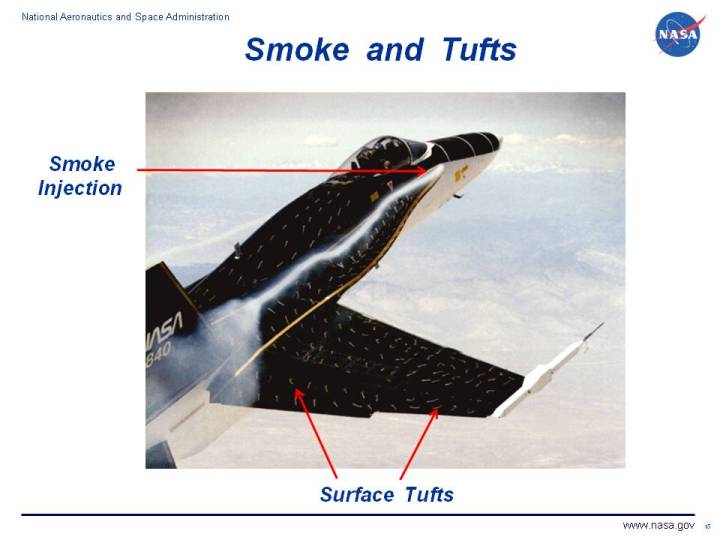
Aerodynamicists use
wind tunnels
to test
models
of proposed aircraft and engine components.
During a test, the model is placed in the
test section
of the tunnel and air is made to flow past the model.
In some wind tunnel tests, the
aerodynamic forces on the model are measured.
In some wind tunnel tests, the model is instrumented to provide
diagnostic information
about the flow of air around the model.
In some wind tunnel tests,
flow visualization
techniques are used to
provide diagnostic information about the flow around the model.
Two of the oldest flow visualization techniques are the use of smoke and tufting.
The figure shows smoke flow and tufts being used on the NASA Dryden F-18 flight vehicle,
but the techniqes are used more often in wind tunnel testing. Smoke is used to visualize
the flow that is away from the surface of the model. Smoke can be used to detect
vortices
and regions of separated flow. On the figure, smoke has been introduced at the corner
of the fuselage and leading edge extension (LEX) to visualize the vortex generated by the
LEX at angle of attack. In the picture we see that vortex is well established until the flow
encounters the vertical stabilzer of the aircraft. Smoke has the advantage that is relatively
inexpensive to produce. Smoke can be injected from the surface or dispersed with a hollow wand
that can be moved through the flow field. The disadvantage of smoke is that it does not work
well at higher speeds (greater than ~300 mph), the smoke must be introduced at the proper
location without altering the flow, and the smoke can leave a residue in the
tunnel or on the model, depending on the type of smoke employed.
Here's a picture of a
paper airplane
in a small smoke tunnel. You can see the smoke swirl as it passes the leading edge of the
wing on the far side of the tunnel. You can watch a
movie
of this experiment which shows the motion of the smoke over the wing.
Thanks to Dwayne Hunt for the production of the movie clip.

Chemical methods for producing smoke include titanium tetrachloride and tin tetrachloride
which re-act with damp air. However, both materials are corrosive. Anhydrous ammonia and
hydrogen sulfide produce smoke, but they also produce odors and, with damp air, sulfuric acid.
Steam and liquid notrogen produce dense smoke with no ill effects. Light oils can also be burned
to produce smoke with some residue.
Tufts are another old visualization technique that is used in both flight test and wind tunnel
testing. Tufts are small lengths of string that are frayed on the ends. Popular materials
for tufts include monofilament nylon, and polyester or cotton No. 60 sewing threads. Tufts may
be coated with flourescant dyes to increase visibility for photography.
The tufts are attached to the surface of the model using some adhesive
such as tape or glue, and as the air flows over the model, the tufts are
blown and point downstream. If the entire model is tufted, as shown on the photo, then regions
of strong cross-flow, reverse flow, or
flow separation
are indicated by the direction of the tufts.
Tufts can also indicate regions of unsteady flow when recorded by film or video.
Tufts are relatively
cheap to produce, although they require time to apply to the model and must be firmly secured
so that they are not blown off the model. Tufts must be cut to the
proper length and weight so that they move with the flow, but do not alter the flow.
Surface tufts only provide
information about the surface flows in the lowest part of the boundary layer. Interpreting
surface patterns to visualize the free stream flow features takes some skill and experience.
Tufts can be mounted on wands to visualize vortices.
You can build an inexpensive
smoke tunnel
using plans provided at this web site.
You can also investigate some wind tunnel visualization techniques by using our
interactive tunnel testing applet.
Navigation ..

- Beginner's Guide Home Page
|
